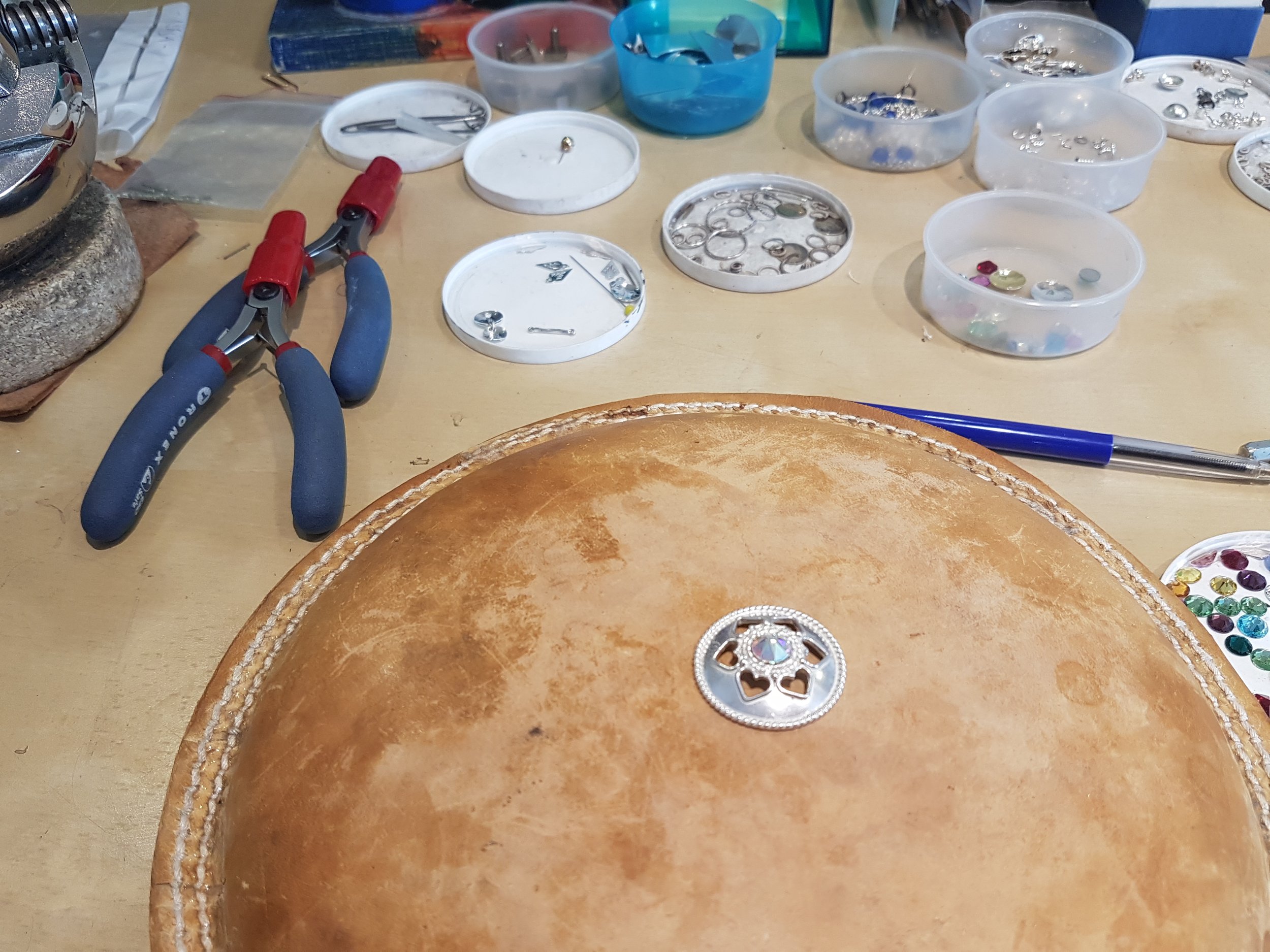Duodji has been close to my heart since my childhood. My first memories are of my ahkku when she was sitting by the wood stove weaving shoebands with an open fire to be able to see clearly. Addja would dry wood over the stove, which would become knives, wooden cups and small parts for sledges.
This would affect my whole life and what I would later work with. In 1980, my husband Thomas and I built a workshop so that we could work with duodji, what we had trained for and chosen as our professions. We also started our company then, which still runs to this day.
I have received many assignments over the years, both small and large, that have been exciting, fun and always a challenge. These include decorations and official assignments within Sápmi (Nordic) and also internationally.
I have made "The world's largest Komsekula". I created everything by hand, from the sheet metal to the finished product, which can be viewed at Tromsö Museum in northern Norway. Another "komsekula" or "magic silver ball" in a slightly smaller size can be found at Riddu Duottar museum in Karasjokk. It is made in the same way as the larger one. These were two very special assignments to me, as there is so much symbolism and history in a komsekula.
I have made specially ordered silver jewelry, risku and hair clips for HRH Crown Princess Victoria and for Princess Estelle, which make up some of my major assignments as a Sami silversmith.
“Sami silver in the church room” is some of my work, which included baptismal fonts, leaflets, candlesticks, etc. I worked with these to help add a touch of sami culture to the church.
At Diehttosiida in Guovdageaidnu there is a stair railing with symbolism from the Sea Sámi culture (1m x3m), which I made by hand, with elements of silver and horn. It is always fun with a challenge, I love it!
I have also studied "Sami practical pedagogy" and worked as a teacher in silversmithing for about 10 years at the Sami education center in Jokkmokk. I have also taught countless courses in silversmithing over the years.
I was a Duodji consultant at Sami Duodji Jokkmokk for five years with a focus on teaching children and young people. Today I still work full time with my craft, which gives me both strength and joy!
Duodji lea álo leamaš mu beroštupmi, juo nuorravuođa rájis. Vuosttas muittut leat go mu áhkku čohkkádii muorrauvnna guoras ja čulddii vuoddagiid. Sus leai uvdnaluŋká rabas, nu ahte oinnii buorebut ja bajábealde uvnna leai áddjá goikadeame duodjeávdnasiid, main galggai duddjot niibbiid, guvssiid ja unna gielkájálásiid.
Dát bođii hábmet olles mu eallima ja dainna mainna galgen bargat boahtteáiggis. 1980:s huksiime, moai Duommá guovttus, bádji vai sáhtiime bargat juste fal dujiiguin, dasa masa leaimme oahpu gazzan ja válljen dan munno ámmáhin. Dalle moai ásaheaimme fitnodaga ja jođihetne dan viel odne ge.
Lean ožžon ollu stuorit ja unnit diŋgojumiid daid jagiid mielde, mat leat leamaš gelddolaččat ja somát čađahit, muhto dat gáibida ollu návccaid. Leat leamaš čiŋadeamit ja almmolaš barggut Sámis (Davviriikkain) muhto maid Riikkaidgaskasaččat.
Lean ráhkadan ”Máilmmi stuorimus šiella”, lea duššefal giehtadahkkon bargu, silbbas gitta válmmas buktagii ja dan sáhttá oaidnit Romssa dávvirvuorkkás Davvi Norggas. Okta iežá ”šiella” dahje ”mágihkalaš šiella”, veaháš unnit hámis gávdnu Riddu-Duottar dávvirvuorkkás Karašjogas, dat lea ráhkaduvvon seamme vuogi mielde go dat stuorit šiella. Erenoamáš diŋgojupmi, go lea hui olu symbolihkka ja historjjá ovtta ”šiellas”.
Erenoamáš diŋgojuvvon silbačiŋat, lea risku ja vuoktačitŋa Ruvdnaprinseassa Victoriai, dat lea maid okta dain mu stuorimus bargguin nugo sámi silbačeahppin. Nubbi man maid sáhtán namuhit lea Šiella prinseassá Estellii.
”Sámi silba girkolanjas”, nugo gástalihtti, rihppaláibelihtti, ginttaljuolggit jna, leat maid ovdamearkat mu bargguin, čalmmustahttin dihte sámivuođa girkolanjas.
Diehttosiiddas Guovdageainnus gávdno tráhpas giehtamuorra mas lea symbolihkka mearrasámi kultuvrras, 1m x 3m, mii lea giehtadahkkon dáidda mainna lean bargan ja mas lea silba ja čoarvi. Lea álo gelddolaš hástalit iežan, ráhkistan daid bargguid.
Lean maid oahpu gazzan, ”Sámi praktihkkalaš pedagogihkka” ja lean bargan silbačeahppi oahpaheaddjin sullii 10 jagi Sámi oahppoguovddážis Johkamohkis, olu silbačeahppi gurssaid lean maid jođihan.
Lean bargan 5 jagi Duodjekonsuleantan Sámi Duoji ovddas dárkkuhuvvon mánáide ja nuoraide. Odne barggan ain ollesáiggi mu giehtadáidagiin, dat addá munnje fámu ja ilu.




